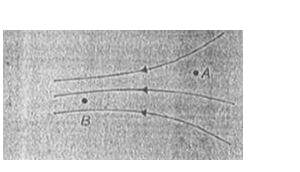The work done in carrying an electron from point A to a point B in an electric is 10 MJ. The potential difference (VB−VA) is then
+2kV
−2kV
+200V
None of these
The correct Answer is:D
Work done by the field,
W=q(−dV)=−e(VA−VB)
=e(VB−VA)=e(VC−VA) (∵VB=VC)
⇒ (VC−VA)=We=(10×106J)1.6×10−19C
=6.25×1025V
Topper's Solved these Questions
- ELECTROSTATICSBook:MHTCET PREVIOUS YEAR PAPERS AND PRACTICE PAPERSChapter:ELECTROSTATICSExercise:PRACTICE EXERCISE (Exercise 2 (MISCELLANEOUS PROBLEMS))
Explore 47 Videos
- ELECTROSTATICSBook:MHTCET PREVIOUS YEAR PAPERS AND PRACTICE PAPERSChapter:ELECTROSTATICSExercise:MHT CET Corner
Explore 29 Videos
- ELECTROSTATICSBook:MHTCET PREVIOUS YEAR PAPERS AND PRACTICE PAPERSChapter:ELECTROSTATICSExercise:MHT CET Corner
Explore 29 Videos
- ELECTRONS AND PROTONSBook:MHTCET PREVIOUS YEAR PAPERS AND PRACTICE PAPERSChapter:ELECTRONS AND PROTONSExercise:MHT CET CORNER
Explore 19 Videos
- FORCEBook:MHTCET PREVIOUS YEAR PAPERS AND PRACTICE PAPERSChapter:FORCEExercise:Exercise 2 (Miscellaneous Problems)
Explore 19 Videos
Similar Questions
Knowledge Check
The work done in carrying a charge of 5μC form a point A to a point B in an electric field is 10mJ. The potential difference (VB−VA) is then
A+2kVB−2kVC+200VD−200VIn figure two points A and B are located in a region of electric field . The potential difference VB−VA is
 APositiveBNegativeCZeroDNone of these
APositiveBNegativeCZeroDNone of theseWork done in carrying an electron from A to B lying on an equipotential surface of one volt potential is
A1 eVB10 eVC1 voltDZero
When a 2μC charge is carried from point A to point B, the amount of work done by the electric field is 50μJ. What is the potential difference and which point is at a higher potential ?
View Solution___ is the amount of work done in carrying a change of 4 C across two points having a potential difference of 18V.
View SolutionThe work done in moving a charge from one point to the other is 20J. If the potential difference between the points is 10V, the charge is:
View Solution15 joule of work has to be done against an existing electric field to take a charge of 0.01 C from A to B. Then the potential difference (VB−VA) is :-
View SolutionA and B are two points in an electric field . If the work done in carrying 4.0C of electric charge from A to B is 16.0J, the potential difference between A and B is
View Solution

